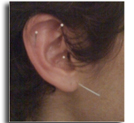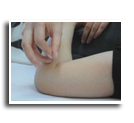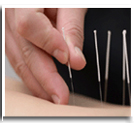|
|


|
 |
Acupuncture and Back Pain
Back pain is one of the most prevalent reasons people seek health care. Millions of working days and countless hours of activity and fun are lost each year due to back pain.
Common Causes of Back Pain Treated with Acupuncture
One of the top causes of back pain are sprains (overstretching one or more of the ligaments in the back) and strains (a rip or tear in the muscle caused by sudden force). This can happen from an injury, poor posture, or improper lifting.
Another source of back pain comes from a herniated disc which is a disc that bulges out from its place between two vertebrae.
Sciatica is another common form of back pain. Sciatica is a term used to describe pain that extends down into the buttocks and leg which comes from an irritation of a larger nerve in the lumbar spine called the sciatic nerve. Sciatica can accompany sprains, strains, herniated discs as well as back pain emanating from other sources.
Traditional Chinese Medicine Patterns of Back Pain
Traditional Chinese Medicine's (TCM) vocabulary is very different from Western medicine. TCM differentiates patterns of back pain.
Common TCM patterns include:
- Deficiency type pain
- Qi and Blood stagnation
- Pain due to Cold Damp Obstruction
Pain that results from deficiency is usually dull, chronic, and improves with rest. It is more common in middle aged and elderly people.
Pain from stagnation is more severe and stabbing in nature. There is stiffness and tightness in the muscles and it worsens with rest. Often this type is seen in occurrences of acute sprains and strains. It can reoccur chronically, thereby indicating an underlying deficiency.
Pain from cold damp obstruction is worse in the morning, exacerbated by cold and damp weather. It improves with heat and may be accompanied by numbness, swelling and a sense of heaviness.
Traditional Chinese Medicine as Treatment for Back Pain
TCM works to restore harmony and energetic balance to the body which stimulates natural healing and promotes health. Acupuncture is one of the primary modalities used and treatment is individual to each patient.
When your practitioner treats your back pain with acupuncture, both local (at the site of pain) and distal (away from the area of pain) needles can be used to help resolve the problem. Distal points are very important, especially in acute pain. Often, needles can be placed in areas other than the back and you can get excellent and quick relief. There are many local points on the back and often a practitioner will palpate your body to find the most sensitive spots and needle those. Other adjuncts to treatment might include: electric stimulation of points, and cupping. Generally, it is advisable to have frequent treatment initially and taper off as the pain diminishes. Herbs can also be helpful in moving blood and reducing inflammation as well as strengthening a deficient condition.
In a Swedish hospital study with patients who experienced chronic low back pain, doctors concluded that acupuncture provided long term pain relief. They also observed improvement in activity levels, better sleep, and consumption of significantly fewer analgesics for the acupuncture group as compared with the group receiving a placebo treatment.
Acupuncture continues to gain popularity in this country because it is an effective treatment of acute and chronic backache. Acute pain can often be cleared up in a few sessions. More treatments may be needed if there is an underlying deficiency, or reoccurring problem, or sciatica.
Attached Scientific Evidences that Acupuncture Works for Back Pain
1) Real and Simulated Acupuncture Appear Effective for Back Pain
By: American Medical Association (AMA)
Newswise — Three types of acupuncture therapy—an individually tailored program, standard therapy and a simulation involving toothpicks at key acupuncture points—appear more effective than usual care for chronic low back pain, according to a report in the May 11 issue of Archives of Internal Medicine, one of the JAMA/Archives journals.
Back pain costs Americans at least $37 billion annually, according to background information in the article. Many patients with this condition are unsatisfied with traditional medical care and seek help from complementary and alternative care providers, including acupuncturists. “Back pain is the leading reason for visits to licensed acupuncturists, and medical acupuncturists consider acupuncture an effective treatment for back pain,” the authors write.
Several recent studies have suggested that simulated acupuncture, or shallow needling on parts of the body not considered key acupuncture points, appear as effective as acupuncture involving penetrating the skin. To expand on these results, Daniel C. Cherkin, Ph.D., of Group Health Center for Health Studies, Seattle, and colleagues compared four different types of treatment in a randomized clinical trial involving 638 adults (average age 47) with chronic low back pain at Group Health in Seattle and Kaiser Permanente Northern California in Oakland.
During the seven-week treatment period, 157 participants received 10 acupuncture treatments in a manner individually prescribed by a diagnostic acupuncturist; 158 underwent a standardized course of acupuncture treatments considered effective by experts for low back pain; 162 received 10 sessions of simulated acupuncture, in which practitioners used a toothpick inside of an acupuncture needle guide tube to mimic the insertion, stimulation and removal of needles; and 161 received usual care. Participants reported changes in their symptoms and in the amount of dysfunction caused by their back pain by phone after eight, 26 and 52 weeks.
“Compared with usual care, individualized acupuncture, standardized acupuncture and simulated acupuncture had beneficial and persisting effects on chronic back pain,” the authors write. At the eight-week follow-up, 60 percent of the participants receiving any type of acupuncture (individualized, standardized or simulated) experienced a clinically meaningful improvement in their level of functioning, compared with 39 percent of those receiving usual care. At the one-year follow-up, 59 percent to 65 percent of those in the acupuncture groups experienced an improvement in function compared with 50 percent of the usual care group.
Several possible explanations exist for the effectiveness of simulated acupuncture, the authors note. Superficial stimulation of acupuncture points may directly stimulate physiological processes that result in reduced pain and improved function. Alternatively, the improvement may be due to another aspect of the treatment experience, such as interaction with the therapist or a belief that acupuncture will be helpful. “These findings raise questions about acupuncture’s purported mechanisms of action,” they write. “It remains unclear whether acupuncture or our simulated method of acupuncture provide physiologically important stimulation or represent placebo or non-specific effects.”
“Our results have important implications for key stakeholders,” they conclude. “For clinicians and patients seeking a relatively safe and effective treatment for a condition for which conventional treatments are often ineffective, various methods of acupuncture point stimulation appear to be reasonable options, even though the mechanism of action remains unclear. Furthermore, the reduction in long-term exposure to the potential adverse effects of medications is an important benefit that may enhance the safety of conventional medical care.”
Source: Arch Intern Med. 2009;169[9]:858-866.
2) Acupuncture Helps Relieve Lower Back Pain
By: Sam Gaines, Staff Writer
A British study published in September 2006 found that acupuncture showed the greatest benefit for patients who suffer pain in the lower back, and is a cost-effective way to treat the problem. Lower back pain is a notoriously common and difficult medical problem to treat.
In the study, one group of patients received 10 sessions of acupuncture over three months, while the other group received none. The acupuncture group reported less pain two years later than did the non-acupuncture group.
In addition, the acupuncture group was more likely to report having no pain at the one-year mark, and reported less worry about their lower back pain and less use of pain drugs to manage it.
Source: BMJ, Sept. 2006
|
Other Conditions
Commonly Treated by Dr. Zheng
- Hot flashes,
menopause, PMS, irregular menstruation
- Stress, depression, anxiety,
insomnia, fatigue
- Hey-fever, sinusitis, asthma,
bronchitis
- Infertility, impotence
- Dizziness, vertigo, Meniere’s disease
- Hypertension, diabetes, obesity
- Stroke, paralysis, Bell’s palsy
- Indigestion, diarrhea, constipation
- Quitting smoking, beauty &
rejuvenation
SPECIAL SERVICES
- We offer free initial consultation
- We accept health insurance plans
which cover for acupuncture treatment. We may contact
your insurance company to verify your acupuncture
benefits. If you need us to do so, please tell us your
insurance information including your full name,
birthday,insurance ID number, and insurance company’s
Tel. number.
|
|
|




